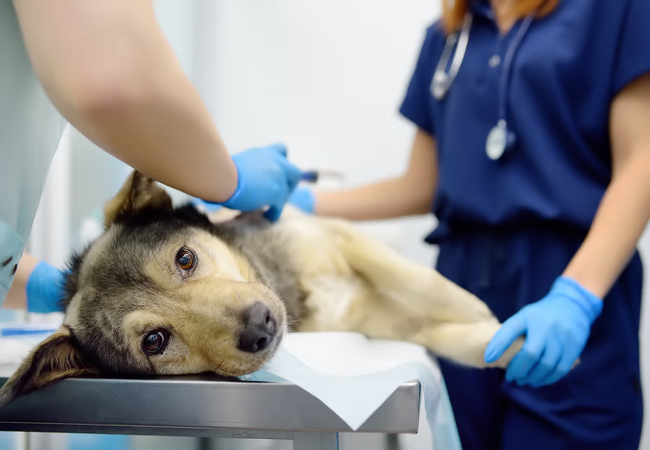🩺 Vet’s 2025 Guide to Canine Stomach & Intestinal Leiomyosarcoma 🩺

In this article
Vet’s 2025 Guide to Canine Gastrointestinal Leiomyosarcoma 🩺 Signs, Diagnosis, Surgery & Home Care
By Dr. Duncan Houston BVSc
💡 What is GI Leiomyosarcoma?
Leiomyosarcoma is a malignant tumor arising from the smooth muscle cells of the stomach, intestines, or cecum in dogs. These tumors are rare but can grow locally and metastasize to organs like liver, spleen, lungs, or kidneys.
🚩 Who Is Affected?
- 🐶 Typically older dogs, mean age ~9–11 years, with both stomach and intestinal presentations.
- No strong breed or gender predisposition, though gastric forms common in older Beagles (~15 yrs).
👀 Clinical Signs
- 🤢 Vomiting (sometimes with blood), diarrhea, weight loss and reduced appetite.
- 🧍 Palpable abdominal mass, discomfort, or distension.
- 🩸 Bloody stools or melena, signs of anemia or lethargy.
- ⚠️ Paraneoplastic signs like hypoglycemia, polydipsia/polyuria may occur.
🧪 Diagnosis
- Physical & blood tests: anemia, leukocytosis, hypoglycemia are common.
- Imaging: Abdominal ultrasound often reveals focal mass, loss of normal GI wall layering; X‑rays or contrast radiography can identify obstructions or masses.
- Endoscopy: visual assessment and biopsy for gastric lesions.
- Surgical biopsy/mass removal: definitive diagnosis via histopathology and immunohistochemistry—distinguishes leiomyosarcoma from GIST or leiomyoma.
🛠 Treatment Options
1. Surgery (Primary Treatment)
- ✂️ Complete resection with wide margins and re-anastomosis; often includes regional lymph node evaluation.
- ⚠️ Ensure stability and manage anemia/hypoglycemia pre- and post-op.
2. Postoperative Care
- 💊 Pain control, IV fluids, nutritional support for several days.
- 📆 Regular follow-ups with bloodwork and imaging every 3–6 months to monitor for recurrence.
3. Advanced Therapies
- 🧬 Chemotherapy/radiation have limited evidence in dogs; surgical removal remains cornerstone.
- 🌱 In the future, targeted therapies may emerge but are currently experimental.
📈 Prognosis & Survival
- 🟢 Median survival ~12–21 months when fully resected; 1‑year survival ~75%, 2‑year ~66%.
- ⚠️ Metastasis occurs in ~38–54% but may not worsen prognosis if the primary tumor removed.
- 🔴 Liver involvement and unresectable tumors carry poorer outcomes.
🏡 Ask A Vet App Home‑Monitoring Tools 📲🐶
- 📆 Schedule medicine, follow-up scans and blood tests.
- 📊 Track appetite, vomiting frequency, stool color/consistency, thirst.
- 📷 Upload abdominal girth photos or gentle palpation videos.
- 🔔 Alerts if symptoms like vomiting, bleeding, lethargy, or polyuria arise.
- 📚 In‑app guides: nutritional support, post-op wound care, glycemic monitoring.
🔑 Key Takeaways 🧠✅
- Leiomyosarcoma is a malignant smooth-muscle tumor in the GI tract, typically in older dogs.
- Signs include vomiting, weight loss, GI bleeding, abdominal mass, and paraneoplastic effects.
- Diagnosis requires imaging, endoscopy, and histopathology.
- Surgical removal offers best prognosis; metastasis doesn’t always worsen outcome.
- Median survival over a year with surveillance; supportive care vital.
- Ask A Vet’s tools empower home monitoring, compliance, and veterinary collaboration.
🩺 Final Thoughts ❤️
In 2025, managing canine GI leiomyosarcoma blends prompt diagnosis, precise surgical removal, vigilant post-op monitoring, and empowered home care. Early detection, nutritional support, and symptom tracking help dogs enjoy longer, quality lives. Through Ask A Vet, owners gain tools to monitor recovery, log symptoms, adhere to follow-ups, and maintain communication with their vet—optimizing outcomes every step of the way 🐾✨.
Visit AskAVet.com and download the app now to track symptoms, schedule check-ins, set medication reminders, upload ultrasound reports, and work closely with your vet to support your dog through GI cancer care. 📲🐶






